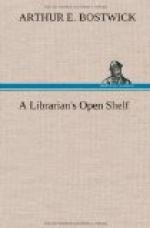Professor Newcomb’s mind was comprehensive in its activity. One might have thought that an intellect occupied to the last in carrying out one of the most stupendous tasks ever attempted by a mathematical astronomer would have had little time or little energy left for other things; but Newcomb took his rest and pleasure in popular articles and interviews. Only a short time before his death he published an essay on aeronautics that attracted wide attention, drawing the conclusions that the aeroplane can never be of much use either as a passenger-carrier or in war, but that the dirigible balloon may accomplish something within certain lines, although it will never put the railways and steamships out of business. In particular, he treated with unsparing ridicule the panic fear of an aerial invasion that so lately seized upon our transatlantic cousins.
Personally, Newcomb was an agreeable companion and a faithful friend. His success was due largely to his tenacity of purpose. The writer’s only personal contact with him came through the “Standard Dictionary,”—of whose definitions in physical science Newcomb had general oversight. On one occasion he came into the office greatly dissatisfied with the definition that we had framed for the word “magnet.”—a conception almost impossible to define in any logical way. We had simply enumerated the properties of the thing,—a course which in the absence of authoritative knowledge of their causes was the only rational procedure. But Newcomb’s mind demanded a logical treatment, and though he must have seen from the outset that this was a forlorn hope, his tenacity of purpose kept him, pencil in hand, writing and erasing alternately for an hour or more. Finally he confessed that he could do no better than the following pair of definitions,—“Magnet, a body capable of exerting magnetic force,” and “Magnetic Force, the force exerted by a magnet.” With a hearty laugh at this beautiful circulus in definiendo he threw down his pencil, and the imperfect and illogical office definition was accepted.
Logical as he was, however, he was in no sense bound by convention. His economics, as has been said, was often unorthodox, and even in his mathematical text-books he occasionally shocked the hide-bound. I well remember an interesting discussion among members of the Yale mathematical faculty just after the appearance of Newcomb’s text-book of geometry, in which he was unsparingly condemned by some because he assumed




